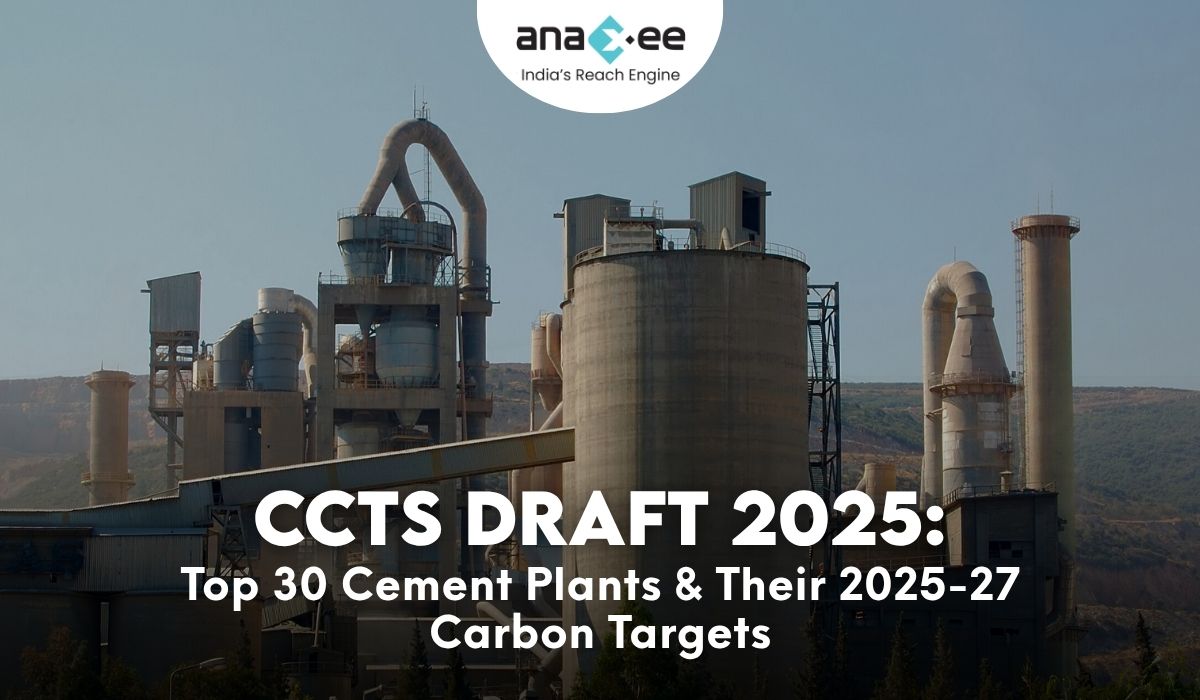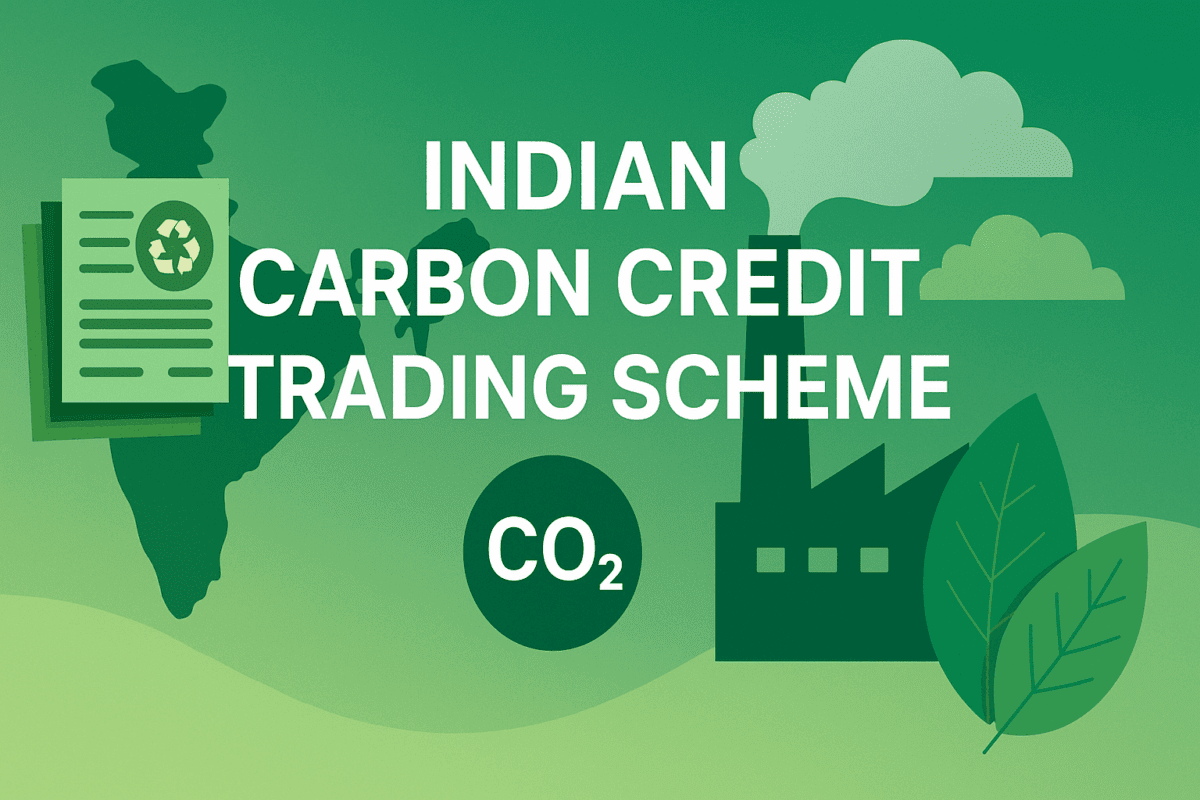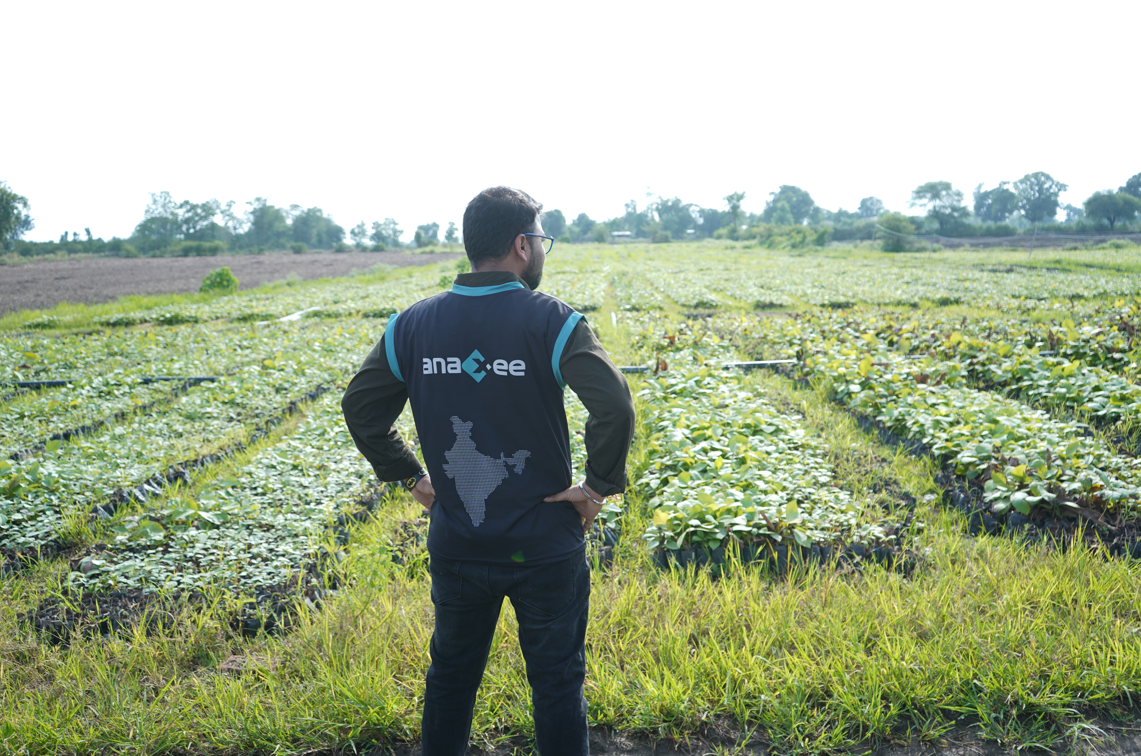CCTS Draft 2025 Puts India’s Cement Kilns on the Clock
“Concrete may build the nation, but clinker bakes the planet.”
India is the world’s #2 cement producer at roughly 450 Mt in 2024, and the sector coughs up ~7 % of the country’s total GHG load.
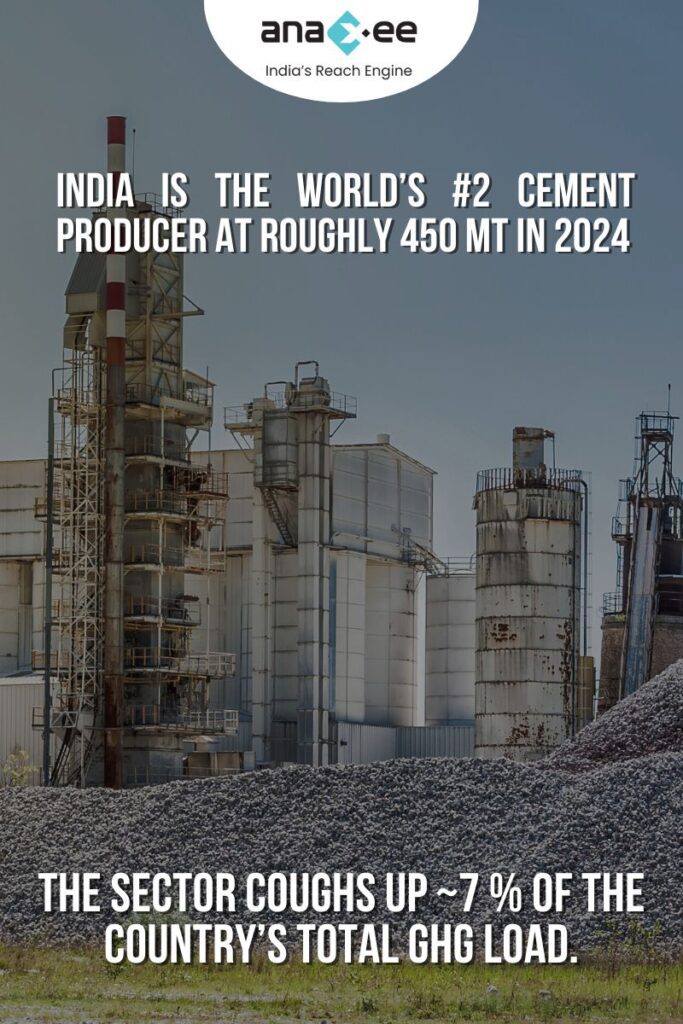
The draft Carbon Credit Trading Scheme (CCTS 2023) finally slaps hard numbers on that footprint: every large kiln now carries a Greenhouse-gas Emission-Intensity (GEI) target for FY 2025-26 and FY 2026-27. Miss the mark? Buy credits or pay a fine. Beat it? Sell the excess and brag about it at the next ESG town-hall.
Below you’ll find:
– Five fast trends (skip the jargon, keep the juice).
– A ranked table of all 30 marquee plants—baseline GEI and both targets.
– A one-click Excel download for nerds who need every row.
– A plain-English explainer on GEI math, plus where offsets could hide.
1 Five trends you should care about
| What’s happening | 💡 Why it matters |
| Clinker-to-cement ratio squeeze – BIS draft standard will let PPC hit 50 % fly-ash. | Every 1 % less clinker chops ~0.8 kg CO₂/t cement. |
| Waste-heat recovery (WHR) binge – 900 MW WHR queued before 2027. | A typical 2 MW unit shaves 3 kWh/t; that’s ≈ 20 kg CO₂/t. |
| Green power PPAs everywhere – UltraTech just signed 370 MW solar-plus-storage bloc. | Lowers scope-2, but CCTS counts direct kiln CO₂ too—so only partial relief. |
| AFR race – Shree, Dalmia running >25 % alternative fuel in some lines. | Each % AFR means less pet-coke; credit price could decide how fast others copy. |
| Anaxee angle – 50 000 Digital Runners can verify kiln-gate AFR receipts & quarry reclamation plots without sending head-office staff on red-eye flights. | Proof beats promises when you monetize GEI over-performance. |
2 Rank-wise list of every plant
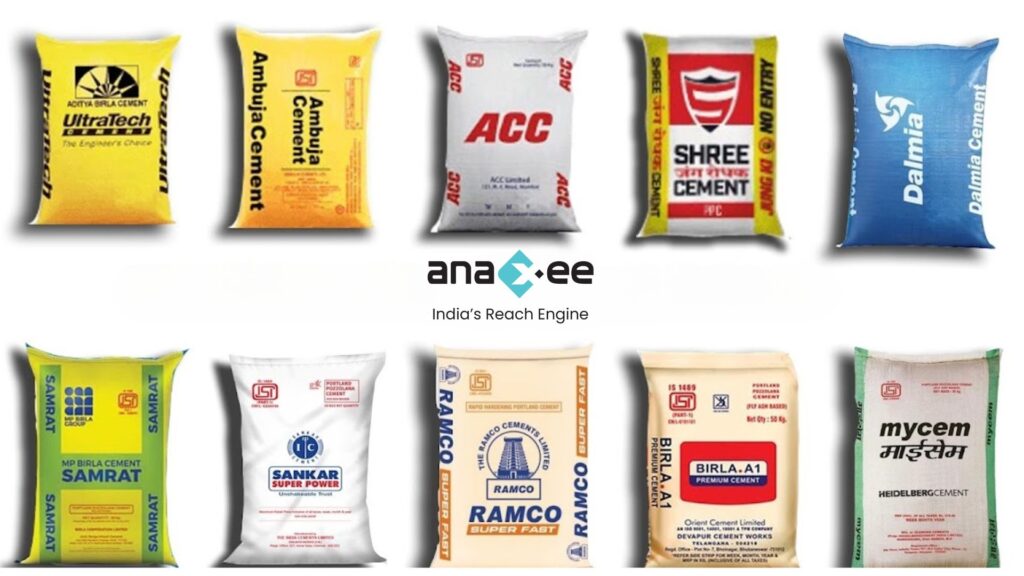
| Sr. No. | Company | Baseline_Output_tonnes | Baseline_GEI_tCO2_per_t | Target_GEI_2025_26 | Target_GEI_2026_27 |
| 1 | UltraTech Cement Ltd, Andhra Pradesh (Tadipatri) | 2403232 | 0.844 | 0.831 | 0.819 |
| 2 | UltraTech Cement Ltd, Gujarat (Kovaya) | 2368155 | 0.852 | 0.839 | 0.826 |
| 3 | ACC Ltd, Wadi, Karnataka | 4676173 | 0.878 | 0.865 | 0.852 |
| 4 | ACC Ltd, Jamul, Chhattisgarh | 4152749 | 0.933 | 0.919 | 0.905 |
| 5 | Ambuja Cements Ltd, Maratha, Maharashtra | 2103444 | 0.939 | 0.925 | 0.911 |
| 6 | Ambuja Cements Ltd, Bhatapara, Chhattisgarh | 4320571 | 0.849 | 0.836 | 0.824 |
| 7 | Shree Cement Ltd, Beawar, Rajasthan | 3675378 | 0.869 | 0.856 | 0.843 |
| 8 | Shree Cement Ltd, Raipur, Chhattisgarh | 3550292 | 0.909 | 0.895 | 0.882 |
| 9 | Dalmia Cement (Bharat) Ltd, Dalmiapuram, Tamil Nadu | 4223216 | 0.904 | 0.89 | 0.877 |
| 10 | Dalmia Cement (Bharat) Ltd, Belgaum, Karnataka | 2694573 | 0.872 | 0.859 | 0.846 |
| 11 | Ramco Cements Ltd, Alathiyur, Tamil Nadu | 3187076 | 0.855 | 0.842 | 0.829 |
| 12 | Ramco Cements Ltd, Jayanthipuram, Andhra Pradesh | 3691112 | 0.94 | 0.926 | 0.912 |
| 13 | JSW Cement, Nandyal, Andhra Pradesh | 3144009 | 0.929 | 0.915 | 0.901 |
| 14 | Birla Corporation, Satna, Madhya Pradesh | 2274686 | 0.861 | 0.848 | 0.835 |
| 15 | JK Cement, Nimbahera, Rajasthan | 3930368 | 0.842 | 0.829 | 0.817 |
| 16 | JK Lakshmi Cement, Sirohi, Rajasthan | 1579616 | 0.925 | 0.911 | 0.897 |
| 17 | Orient Cement, Devapur, Telangana | 1833271 | 0.936 | 0.922 | 0.908 |
| 18 | India Cements, Malkapur, Telangana | 4027798 | 0.872 | 0.859 | 0.846 |
| 19 | Heidelberg Cement India, Damoh, Madhya Pradesh | 3348137 | 0.825 | 0.813 | 0.8 |
| 20 | OCL India, Rajgangpur, Odisha | 3264715 | 0.946 | 0.932 | 0.918 |
| 21 | Penna Cement, Tandur, Telangana | 4674025 | 0.866 | 0.853 | 0.84 |
| 22 | Sagar Cements, Mattampally, Telangana | 1518153 | 0.838 | 0.825 | 0.813 |
| 23 | Prism Johnson, Satna, Madhya Pradesh | 2252719 | 0.885 | 0.872 | 0.858 |
| 24 | Nuvoco Vistas, Mejia, West Bengal | 3638047 | 0.866 | 0.853 | 0.84 |
| 25 | Wonder Cement, Nimbahera, Rajasthan | 1567511 | 0.853 | 0.84 | 0.827 |
| 26 | Kesoram Cement, Sedam, Karnataka | 2675449 | 0.897 | 0.884 | 0.87 |
| 27 | Star Cement, Lumshnong, Meghalaya | 4338057 | 0.864 | 0.851 | 0.838 |
| 28 | Century Cement, Baikunth, Chhattisgarh | 1864135 | 0.855 | 0.842 | 0.829 |
| 29 | Anjani Portland Cement, Gudimalkapur, Telangana | 3559336 | 0.949 | 0.935 | 0.921 |
| 30 | My Home Industries, Mellacheruvu, Telangana | 3012556 | 0.841 | 0.828 | 0.816 |
Units: GEI in t CO₂ per tonne clinker. Ranking = highest baseline output first (the big emitters).
(Data transcribed from the draft schedule; figures will be final once MoP issues the gazette.)
3 GEI=
-GEI = total kiln & calciner CO₂ / tonnes of clinker.
-Two targets: soft-landing FY 25-26, then hard stop FY 26-27.
-Penalty = credit shortfall × 2 × credit-price (rumoured ₹800–₹1 000 / t).
-Surplus = tradable asset—cash in or bank for future years.
If your kiln sits at 0.92 t/t and the target is 0.90, you owe ~20 kg per tonne. Produce 4 Mt = 80 000 t shortfall → ₹64–80 cr liability at ₹800–₹1 000. Motivation enough?
4 Who buys, who sells?
| Likely Credit Buyers | Likely Credit Sellers |
| ACC Jamul, Ambuja Maratha – older wet-kiln lineage, pet-coke heavy. | UltraTech Kovaya – already at 0.83 t, targets barely nudge. |
| Orient Devapur – high clinker factor, limited WHR. | JK Cement Nimbahera – AFR > 25 %, big WHR unit. |
| Century Baikunth – legacy, low alternative fuel. | Ramco Alathiyur – mid-life kiln, WHR + solar PPA in place. |
5 How do they close the gap?
-
Fly-ash frenzy: PPC can legally hit >45 % ash under new BIS draft—fastest lever.
-
AFR switch: Tyre-chips, RDF, agri-waste all count; 10 % AFR ≈ 5 % GEI drop.
-
Calcined clay blends: LC³ pilot at Tata’s Jamshedpur R&D shows 40 % clinker cut.
-
WHR/solar hybrids: Slashes power-plant coal but only marginal GEI change—still worth credits in other schemes.
-
Offset route: Buy agroforestry, biochar, biogas-stove credits—hello, Anaxee last-mile MRV.
6 FAQ – asked in the canteen
Q : Why not rank by GEI instead of output?
A: Big tonnes = big emissions = big credit demand. Output tells you who moves the market.
Q : Is 0.82 t really “best in class”?
A: European BAT hovers around 0.76 t, but they burn 50 % AFR and pay €90 / t EU-ETS. India can catch up if credit price bites.
Q : Will the targets tighten in 2028?
A: Almost certainly—MoP hinted at 2 % year-on-year ratchet after the pilot phase.
7. So what?/Call-to-Action
Cutting kiln CO₂ isn’t romantic—it’s limestone chemistry and a pile of money. But with CCTS, every percent saved is a tradable rupee. Whether you retrofit a pre-heater cyclones or co-fire sugarcane trash, you’ll need bullet-proof proof. Anaxee’s 50 000 Digital Runners can collect that proof from quarries to village pellet plants—so you only sweat the board meetings, not the field sweat.
Ready to game-plan your credit strategy?
▶️ Ping the Anaxee Climate Projects desk. Let’s clinker-cancel together.

